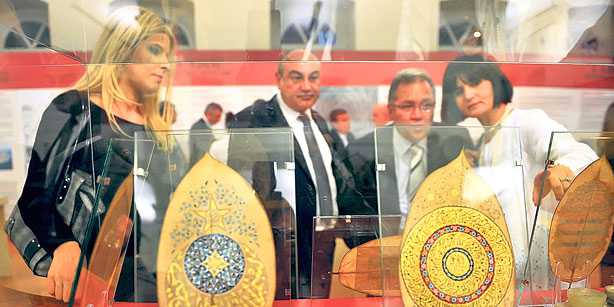21 November 2010, Sunday / FATMA TURAN , İSTANBUL
A sentence written with care in a notebook by the Grand Bazaar’s governing board talks of how the products and the people who fill the corridors of the historic covered shopping center are “citizens of Istanbul and the goods of all Turkey.”

These days, the 550-year history of this famous İstanbul site is on display in an exhibition called “10 Adımda Kapalıçarşı Sergisi” (The Grand Bazaar in 10 Steps), which is on display at the İş Bankası Museum, containing original documents connected with the history of the Grand Bazaar and engravings, as well as jewelry and calligraphy — much of it boasting dazzling gold and silver work. At the same time, there are 360 degree displays from various vantage points in this ancient covered shopping bazaar available for viewing. The show was curated by Professors Önder Küçükerman and Kenan Mortan.
The opening for this new exhibition was hosted by İş Bankası CEO Caner Çimenbiçer and İş Bankası General Manager Ersin Özince, and İstanbul Governor Hüseyin Avni Mutlu was in attendance. Noting that İstanbul was home to a wealth of different cultures and civilizations, Çimenbiçer said he believed that the exhibition would contribute on an aesthetic level to the transformation of the city into the financial center of the region. Özince noted that a shopping center where 4,000 merchants function in harmony as in the Grand Bazaar exists nowhere else in the world. The ancient shopping center was constructed during the era of Fatih Sultan Mehmet and has maintained its level of activity for the past six centuries.
The 10 parts of this new exhibition include the Ottoman market, the Ottoman merchant, İstanbul hans (inns), the trade zone of the historic peninsula, various eras of the Grand Bazaar, the market’s inns and caravansarays, the streets of the area, İş Bankası in İstanbul and the World Financial Center. The Grand Bazaar has 16 doors. It is estimated that the combined worth of the 3,285 businesses it hosts is $1.5 billion, and there are 24 inns, one mosque, two mescits, seven fountains, one water tank, one coffee house, five restaurants and four cafeterias in the Grand Bazaar. Visitors will be able to tour this exhibition until Feb. 27.
Since 1460
An important trade center for hundreds of years now, the Grand Bazaar is, as shown in this new exhibition, also a place where designs and products are developed, as well as being a significant financial center. The exhibition, which features many documents, products and presentations from the Grand Bazaar Foundation, spotlights the various eras of this important shopping site, built in 1460, its economic and architectural developments, its role in Istanbul trade life and its cultural and artistic heritage for Turkey.
Giving his heart to leaves: “The leaves on the branches were alone as they fell to the ground, but this loneliness was ended by a love for art. He blew new life into these leaves by a special calligraphy done on dry leaves.” If you have a chance to visit this new exhibition, you can see motifs drawn by Grand Bazaar merchant Nick Merdenian, who has worked at the ancient shopping site since 1968.
via Today’s Zaman, your gateway to Turkish daily news.